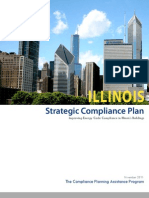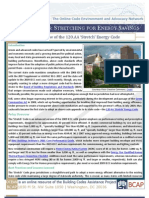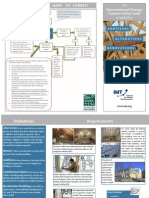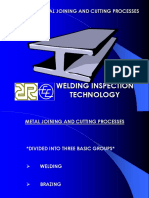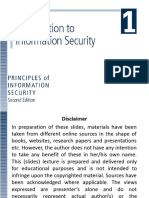Austin September 16 2011 Report
Austin September 16 2011 Report
Uploaded by
bcap-oceanCopyright:
Available Formats
Austin September 16 2011 Report
Austin September 16 2011 Report
Uploaded by
bcap-oceanCopyright
Available Formats
Share this document
Did you find this document useful?
Is this content inappropriate?
Copyright:
Available Formats
Austin September 16 2011 Report
Austin September 16 2011 Report
Uploaded by
bcap-oceanCopyright:
Available Formats
Trip Report: September 16 2011, Austin, Texas
Submitted by: Mark Lessans, Program Associate, Building Codes Assistance Project
Meetings Held
September 16, 9:00 AM 12:00 PM CST
Participants: BCAP: Mark Lessans, Maria Ellingson, Mike DeWein (via phone) Texas State Energy Conservation Office (SECO): Felix Lopez, Dub Taylor Texas Comptroller of Public Accounts, Public Outreach: Alison Nathan
Purpose: To meet with the Texas State Energy Conservation Office (SECO) to begin development of the Strategic Compliance Plan for the state of Texas, using the recently complete Texas Gap Analysis report as the first step in considering tactics to achieve 90 percent compliance with the IECC 2009 code by 2017. Summary: We reviewed the 12 recommendations in the Gap Analysis Report, and discussed the importance and feasibility for realistically helping to achieve the goal of 90 percent compliance with the 2009 IECCC by 2017. Each recommendation was discussed in relation to its purpose in the strategic plan, and the structure of the report was discussed further. Meeting notes: The flow chart and report outline appear to be a good start and viable model. Many of the recommendations from the gap analysis not addressed would require legislative change at the state level, so they would need to be passed off to advocacy organizations that have the capability to lobby (SECO does not). Energy Codes Compliance Coalition A good idea and doable solution, but it is imperative to include all stakeholders, especially the Texas Association of Builders (TAB). TAB has been relatively supportive of energy codes in the past. Currently, an advocacy group headed by Tod Wickersham, Beneficial Results (see Additional Notes) meets regularly with Dub Taylor from SECO, and they are open to evolving into the coalition and including the necessary stakeholders. Securing Funding Pre-ARRA funding, Texas used other funding for codes (some SEP, state funds (state appropriates funding to SECO for program activities, one of which is building code training)); they also secured some grant funding to supplement that.
The timing of ARRA was good as they jumped from 2001- to 2009 version codes with help from ARRA funds. The fallback for funding without ARRA would be at a reduced level. Prior to ARRA, SECO partnered with other organizations (such as TAB) to minimize costs for training. Outreach and training could be maintained by SECO regardless of utility and ARRA funding. The real need is enforcement within cities and is underfunded. This is the opportunity for sustained utility funding. SECO would greatly appreciate knowing details on how other states (such as WA or IL) have structured their funding to provide for energy codes work. We agreed to put some information together for them as part of their strategic plan. Measurement and Verification SECO has not completed any M&V studies, but Texas A&M Energy Systems Laboratory (ESL) has developed a compliance software program that contains M&V components. Theyve pilot tested the software, and although the PNNL checklist is cumbersome, the software seems to work well, and would allow SECO to track energy code compliance across multiple jurisdictions if code officials were to use this software. Entries made by code officials in the field would be entered into a master database at the state level. This software seems quite innovative and could revolutionize the way states collect data from on-site visits. The stall in moving forward lies with the rights to the software the software developer feels they own the rights and wants to make money from the product. It is unclear what percentage of state funding went into developing this software. Dub Taylor and Felix Lopez will follow up with the software developer to determine whether or not they can move forward, how the contract reads (whether state has ownership), and determine the next steps. SECO was interested in other states compliance study efforts, and BCAP agreed to send them current studies as soon as they became public. Consumer and Professional Outreach Texas has not taken on a consumer energy code outreach program, and Alison Nathan was concerned that the state may be too big to effectively reach out to everyone. That being said, everyone in attendance was very interested at the possibility of a consumer outreach campaign. BCAP staff offered recently created consumer materials which can be altered and used for state-specific resources, and will put Alison in contact with Consumers Union if interested. Alison agreed that utilizing the associations of counties, cities, and municipalities would be an ideal way to reach local governments and ideally, consumers. Training SECO is currently sponsoring a large number of trainings, which is being completed by Apple Energy Group (AEG) with BCAP assistance. These trainings are being offered in many different cities and towns throughout Texas, and video content from trainings will be posted online for greater access by others. Regardless, Code Ambassadors appears to be a viable option, as long as SECO can find funding for it. Additional Notes Construction outside of city lines are not subject to building codes compliance of any kind, as the counties do not have jurisdiction to enforce codes. It is estimated that this makes up <10% of the states
total construction, though no analysis has been completed. Enabling counties to enforce codes would require legislative change, something that has been attempted in the past. Felix suggested that advocating for county enforcement, and any necessary construction analyses, be taken on by RECA. SECO currently has 10 blower door testers, 10 duct blasters, and 10 infrared air leakage testers in its possession, bought with ARRA funds. The original intent of their purchase was to loan them to building departments for use with 2009 IECC compliance testing, however this may be too much of an administrative hassle. SECO is considering using them for 3rd party rater training instead, and is evaluating other options with what to do with the tools. Mark Lessans and Maria Ellingson also met with Tod Wickersham of Beneficial Results while in town. Todd has begun to create a group of businesses to develop a collective voice in support of energy efficiency businesses. He is open to expanding the topic to building codes. SECO is also open to the idea of considering this group as a potential energy codes advocacy group in the future.
You might also like
- The Breuss Cancer Cure PDF Ebook Free Download - Rudolf BreussDocument140 pagesThe Breuss Cancer Cure PDF Ebook Free Download - Rudolf Breusspdf ebook free download90% (21)
- Wohascum ProblemsDocument246 pagesWohascum ProblemsNafis100% (1)
- Water Bill 042023Document1 pageWater Bill 042023Sage GriffinNo ratings yet
- ACYAVA1 Comprehensive Examination Quiz Instructions: Started: Jun 4 at 13:00Document37 pagesACYAVA1 Comprehensive Examination Quiz Instructions: Started: Jun 4 at 13:00Joel Kennedy BalanayNo ratings yet
- E-Government To Combat Corruption in The Asia Pacific RegionDocument7 pagesE-Government To Combat Corruption in The Asia Pacific RegionVineeth CmNo ratings yet
- 40511stOperatorsManual PDFDocument102 pages40511stOperatorsManual PDFNam Ngô PhươngNo ratings yet
- ACCT3302 Financial Statement Analysis Tutorial 2: Accrual Accounting and Income DeterminationDocument3 pagesACCT3302 Financial Statement Analysis Tutorial 2: Accrual Accounting and Income DeterminationDylan AdrianNo ratings yet
- Social Practice of The Language 1Document14 pagesSocial Practice of The Language 1Oscr IscNo ratings yet
- 2696 - INFO - BacTALERT - Seeded StudyDocument11 pages2696 - INFO - BacTALERT - Seeded StudyRickyNo ratings yet
- Texas Strategic Compliance PlanDocument26 pagesTexas Strategic Compliance Planbcap-oceanNo ratings yet
- Compliance Planning Assistance Project: Michael Dewein Technical Director Building Codes Assistance Project July 12, 2010Document12 pagesCompliance Planning Assistance Project: Michael Dewein Technical Director Building Codes Assistance Project July 12, 2010bcap-oceanNo ratings yet
- Texas Training AssessmentDocument11 pagesTexas Training Assessmentbcap-oceanNo ratings yet
- Illionois Strategic Compliance Plan - 0Document26 pagesIllionois Strategic Compliance Plan - 0bcap-oceanNo ratings yet
- Building Codes Assistance Project: Annual ReportDocument32 pagesBuilding Codes Assistance Project: Annual Reportbcap-oceanNo ratings yet
- Building Codes Assistance Project: Code Adoption and ImplementationDocument2 pagesBuilding Codes Assistance Project: Code Adoption and Implementationbcap-oceanNo ratings yet
- Building Codes Assistance Project: Code Adoption and ImplementationDocument2 pagesBuilding Codes Assistance Project: Code Adoption and Implementationbcap-oceanNo ratings yet
- Illionois Strategic Compliance PlanDocument26 pagesIllionois Strategic Compliance Planbcap-oceanNo ratings yet
- Colorado Strategic Compliance Plan FINALDocument24 pagesColorado Strategic Compliance Plan FINALbcap-oceanNo ratings yet
- Illionois Strategic Compliance PlanDocument26 pagesIllionois Strategic Compliance Planbcap-oceanNo ratings yet
- Delaware Strategic Compliance PlanDocument26 pagesDelaware Strategic Compliance Planbcap-oceanNo ratings yet
- Week of October 24 2011Document4 pagesWeek of October 24 2011bcap-oceanNo ratings yet
- Colorado Strategic Compliance PlanDocument24 pagesColorado Strategic Compliance Planbcap-oceanNo ratings yet
- Compliance Planning Assistance (CPA) Program: Helping States Achieve 90% Energy Code Compliance by 2017Document24 pagesCompliance Planning Assistance (CPA) Program: Helping States Achieve 90% Energy Code Compliance by 2017bcap-oceanNo ratings yet
- Week of April 2Document6 pagesWeek of April 2bcap-oceanNo ratings yet
- Draft Shared Services PlanDocument7 pagesDraft Shared Services PlanKelsey O'ConnorNo ratings yet
- 2011 11 30 CCTC Statement - EfmDocument3 pages2011 11 30 CCTC Statement - EfmEugene CurryNo ratings yet
- Idaho Strategic Plan For 2009 IECCDocument26 pagesIdaho Strategic Plan For 2009 IECCbcap-oceanNo ratings yet
- Torchlight #27 - Its Not A WrapDocument6 pagesTorchlight #27 - Its Not A WrapNancy AndersonNo ratings yet
- Land Use and Local Government Advisory Panel 2.1Document18 pagesLand Use and Local Government Advisory Panel 2.1OANo ratings yet
- West Virginia Strategic Compliance Plan FINALDocument22 pagesWest Virginia Strategic Compliance Plan FINALbcap-oceanNo ratings yet
- Open Source and The Cloud - White PaperDocument9 pagesOpen Source and The Cloud - White Paperde_dassNo ratings yet
- South Carolina Strategic Compliance PlanDocument22 pagesSouth Carolina Strategic Compliance Planbcap-oceanNo ratings yet
- Canada Measuring ESDDocument56 pagesCanada Measuring ESDParkElsewhereNo ratings yet
- Week of October 17 2011Document5 pagesWeek of October 17 2011bcap-oceanNo ratings yet
- Texas Rising: Fall 2011Document11 pagesTexas Rising: Fall 2011Texas Comptroller of Public AccountsNo ratings yet
- Retrofitting InstitutionsDocument3 pagesRetrofitting InstitutionsBigIdeasforJobsNo ratings yet
- Massachusetts Stretching For Energy SavingsDocument2 pagesMassachusetts Stretching For Energy Savingsbcap-oceanNo ratings yet
- New Mexico Strategic PlanDocument26 pagesNew Mexico Strategic Planbcap-oceanNo ratings yet
- CAC Energy Efficiency and Housing November 18, 2020 FINALDocument18 pagesCAC Energy Efficiency and Housing November 18, 2020 FINALOANo ratings yet
- Best Practices Arizona SWEEPDocument67 pagesBest Practices Arizona SWEEPbcap-oceanNo ratings yet
- Is Your State Ready To Handle The Influx of Federal Funds For Expanding BroadbandDocument5 pagesIs Your State Ready To Handle The Influx of Federal Funds For Expanding BroadbandLiar LiarNo ratings yet
- Week of March 26Document5 pagesWeek of March 26bcap-oceanNo ratings yet
- Winter 2012 Edition: Collaboration AgreementDocument3 pagesWinter 2012 Edition: Collaboration Agreementbcap-oceanNo ratings yet
- CAC Meeting - Transportation and Land Use & Local Government 5.10.21Document29 pagesCAC Meeting - Transportation and Land Use & Local Government 5.10.21OANo ratings yet
- Energy Use Disclosure and Benchmarking Proposals "Hot Issue" in CommunitiesDocument1 pageEnergy Use Disclosure and Benchmarking Proposals "Hot Issue" in Communitiesapi-154620308No ratings yet
- BCAP Comments To BECP On 90 Percent Compliance Strawman June 22 2009Document2 pagesBCAP Comments To BECP On 90 Percent Compliance Strawman June 22 2009bcap-oceanNo ratings yet
- INFORMATION TECHNOLOGY REFORM Progress Made More Needs To Be Done To Complete Actions and Measure ResultsDocument18 pagesINFORMATION TECHNOLOGY REFORM Progress Made More Needs To Be Done To Complete Actions and Measure ResultsFedScoopNo ratings yet
- A Transactive Energy Future PDFDocument6 pagesA Transactive Energy Future PDFGilberto CastrejeNo ratings yet
- Reforms Abstracts WebDocument2 pagesReforms Abstracts WebTheNafinaArchiveNo ratings yet
- ACEEE Lessons LearnedDocument11 pagesACEEE Lessons Learnedvaibhav.sharmaNo ratings yet
- CAC Power Generation Meeting 12.21Document10 pagesCAC Power Generation Meeting 12.21OANo ratings yet
- Title: Electronic Government: Connecting People Purpose: in The Philippines, There Are Traces of Electronic Government Being Enacted inDocument5 pagesTitle: Electronic Government: Connecting People Purpose: in The Philippines, There Are Traces of Electronic Government Being Enacted inPatrick RamosNo ratings yet
- ENO On-the-Right-Track Rail Transit Delivery IntlDocument27 pagesENO On-the-Right-Track Rail Transit Delivery IntlUnnamed OneNo ratings yet
- Michigan Strategic Compliance Plan FINALDocument22 pagesMichigan Strategic Compliance Plan FINALbcap-oceanNo ratings yet
- Office of Citizen Services & Innovative Technologies FY 2011 Annual ReportDocument48 pagesOffice of Citizen Services & Innovative Technologies FY 2011 Annual ReportFedScoopNo ratings yet
- Brief: Mobility: What'S Next For Federal Mobility?Document4 pagesBrief: Mobility: What'S Next For Federal Mobility?FedScoopNo ratings yet
- 2007 GuijarroDocument13 pages2007 Guijarroazzoune3omarNo ratings yet
- RAP Neme EfficiencyasaTandDresource 2012 Feb 14Document40 pagesRAP Neme EfficiencyasaTandDresource 2012 Feb 14Meral SüzerNo ratings yet
- E Government Thesis PDFDocument10 pagesE Government Thesis PDFcarliferranteolathe100% (2)
- Digital Infrastructure Research RFP AbstractsDocument4 pagesDigital Infrastructure Research RFP AbstractsTechCrunchNo ratings yet
- 0193-000205Document16 pages0193-000205ajis purnomoNo ratings yet
- Week of September 12 2011Document7 pagesWeek of September 12 2011bcap-oceanNo ratings yet
- Department of Justice E-Government Status Report - FY 2005Document7 pagesDepartment of Justice E-Government Status Report - FY 2005420No ratings yet
- North Carolina Judicial Branch Letter On EcourtsDocument4 pagesNorth Carolina Judicial Branch Letter On EcourtsJames BriertonNo ratings yet
- Nebraska Strategic Plan - Critical Pathways To 90 Percent ComplianceDocument7 pagesNebraska Strategic Plan - Critical Pathways To 90 Percent Compliancebcap-oceanNo ratings yet
- Teresa Scassa - Administrative Law and The Governance of Automated Decision-Making - CanadaDocument29 pagesTeresa Scassa - Administrative Law and The Governance of Automated Decision-Making - CanadaHellenNo ratings yet
- Measuring Up: The Business Case for GIS, Volume 3From EverandMeasuring Up: The Business Case for GIS, Volume 3Cory FlemingNo ratings yet
- Mission Control: The Roadmap to Long-Term, Data-Driven Public InfrastructureFrom EverandMission Control: The Roadmap to Long-Term, Data-Driven Public InfrastructureNo ratings yet
- Alabama Fact SheetDocument2 pagesAlabama Fact Sheetbcap-oceanNo ratings yet
- Dallas AnalysisDocument7 pagesDallas Analysisbcap-oceanNo ratings yet
- San Antonio AnalysisDocument5 pagesSan Antonio Analysisbcap-oceanNo ratings yet
- San Antonio AnalysisDocument5 pagesSan Antonio Analysisbcap-oceanNo ratings yet
- Dallas AnalysisDocument7 pagesDallas Analysisbcap-oceanNo ratings yet
- Dallas 2012 IECC HandoutDocument2 pagesDallas 2012 IECC Handoutbcap-oceanNo ratings yet
- Energy Code Best Practices: How To Establish An Energy Codes Compliance CollaborativeDocument29 pagesEnergy Code Best Practices: How To Establish An Energy Codes Compliance Collaborativebcap-oceanNo ratings yet
- CPA Best PracticesDocument6 pagesCPA Best Practicesbcap-oceanNo ratings yet
- Energy Code Best Practices: How To Establish An Energy Codes Compliance CollaborativeDocument29 pagesEnergy Code Best Practices: How To Establish An Energy Codes Compliance Collaborativebcap-oceanNo ratings yet
- Commercial BuildingsDocument2 pagesCommercial Buildingsbcap-oceanNo ratings yet
- Residential BuildingsDocument2 pagesResidential Buildingsbcap-oceanNo ratings yet
- Energy Code Best Practices: How To Establish An Energy Codes Compliance CollaborativeDocument29 pagesEnergy Code Best Practices: How To Establish An Energy Codes Compliance Collaborativeapi-124799407No ratings yet
- Commercial BuildingsDocument2 pagesCommercial Buildingsbcap-oceanNo ratings yet
- Residential Insulation and Air LeakageDocument2 pagesResidential Insulation and Air Leakagebcap-oceanNo ratings yet
- Residential Insulation and Air LeakageDocument2 pagesResidential Insulation and Air Leakagebcap-oceanNo ratings yet
- Residential BuildingsDocument2 pagesResidential Buildingsbcap-oceanNo ratings yet
- Commercial LightingDocument2 pagesCommercial Lightingbcap-oceanNo ratings yet
- Syllabus-BA006IU - Business CommunicationDocument10 pagesSyllabus-BA006IU - Business Communicationnhunhp04No ratings yet
- Aws Module 3Document43 pagesAws Module 3rex valencia100% (1)
- Constructing and Deconstructing The Gokstad MoundDocument18 pagesConstructing and Deconstructing The Gokstad Moundsnickercat.meowNo ratings yet
- Kniha Insprirace V ProjektovaniDocument274 pagesKniha Insprirace V ProjektovaniAndré BiscayaNo ratings yet
- IS Chapter 2Document44 pagesIS Chapter 2Arishba AftabNo ratings yet
- MJD340 (NPN), MJD350 (PNP) High Voltage Power Transistors: DPAK For Surface Mount ApplicationsDocument8 pagesMJD340 (NPN), MJD350 (PNP) High Voltage Power Transistors: DPAK For Surface Mount Applicationshalil ibrahim soysalNo ratings yet
- Chapter 3 - Classical Theories of Economic Growth and DevelopmentDocument103 pagesChapter 3 - Classical Theories of Economic Growth and DevelopmentKenzel lawasNo ratings yet
- Asssignment Transaction, Jounal, Ledger, Trial Balance, Adjusting Entry, Final Account, ClosingDocument2 pagesAsssignment Transaction, Jounal, Ledger, Trial Balance, Adjusting Entry, Final Account, ClosingShakil HossainNo ratings yet
- Block ListDocument9 pagesBlock ListMohd AnasNo ratings yet
- Abb Parts Fiser68261899 PDFDocument2 pagesAbb Parts Fiser68261899 PDFsuzell9fiorella9ascaNo ratings yet
- 30 Mantenimiento - Ecogreen Molino Granulador PDFDocument26 pages30 Mantenimiento - Ecogreen Molino Granulador PDFWilliam Moreno IbañezNo ratings yet
- "Music, Terror and Manipulation Under The Greek Junta": Fact SheetDocument3 pages"Music, Terror and Manipulation Under The Greek Junta": Fact SheetEffie VlachouNo ratings yet
- The Golden Compass - Phillip Pullman Book ReviewDocument1 pageThe Golden Compass - Phillip Pullman Book Reviewharshit.selvakumarNo ratings yet
- MAT538 Tutorial 2B (Chapter 2-Part 2)Document4 pagesMAT538 Tutorial 2B (Chapter 2-Part 2)Husnul HakimNo ratings yet
- Super Dead Man 222 DialogDocument13 pagesSuper Dead Man 222 DialogAyu RahmawatiNo ratings yet
- Osteoporosis & OsteomalaciaDocument29 pagesOsteoporosis & OsteomalaciaKeith OmwoyoNo ratings yet
- Action Adventure GamesDocument11 pagesAction Adventure Gamesapi-263881401No ratings yet
- Delivery Header - Order Fulfillment - SAP LibraryDocument2 pagesDelivery Header - Order Fulfillment - SAP Libraryyaswanthrdy100% (1)
- TutorialDocument3 pagesTutorialmrx9r49nbyNo ratings yet
- MatrikonOPC Server For IEC 61850 DatasheetDocument2 pagesMatrikonOPC Server For IEC 61850 DatasheetengacostaNo ratings yet
- Semisolid Dosage FormDocument77 pagesSemisolid Dosage FormMonyratanak LimNo ratings yet
- Gender Recong Paper 4Document9 pagesGender Recong Paper 4Kumara SNo ratings yet












